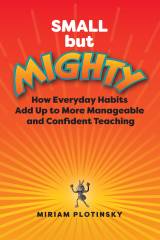From Small however Mighty: How On a regular basis Habits Add As much as Extra Manageable and Assured Educating (pp. 78-80), by M. Plotinsky, 2024, ASCD. Copyright 2024 by ASCD. Reprinted with permission.
Over the previous a number of years, formative approaches have gained important traction as a most well-liked methodology of evaluation, thanks largely to the ideology behind the follow. Not too way back, college students had been taught materials in school rooms, primarily through stand-and-deliver direct instruction, and had been subsequently requested to exhibit their studying in what’s now known as a summative or “high-stakes” evaluation. On this mannequin, it wasn’t simply grades that had been forged in stone as soon as check outcomes got here again; there was additionally an assumption that college students knew the fabric sufficient to maneuver ahead with new ideas and that anybody who was falling behind wanted to both catch up or succumb to continued (maybe everlasting) battle.
 This sink-or-swim method to schooling has misplaced reputation over time, notably within the wake of each elevated consciousness of equity-driven instruction and amid the aftereffects of instructing and studying through the pandemic. Turning a blind eye to pupil battle is dangerous, and so is closing down alternatives for progress. Moreover, the concept of figuring out pupil achievement inside any given content material commonplace solely on the shut of a unit of instruction is essentially unsound. Ideally, lecturers clear up confusion and test for understanding constantly all through a unit of research.
This sink-or-swim method to schooling has misplaced reputation over time, notably within the wake of each elevated consciousness of equity-driven instruction and amid the aftereffects of instructing and studying through the pandemic. Turning a blind eye to pupil battle is dangerous, and so is closing down alternatives for progress. Moreover, the concept of figuring out pupil achievement inside any given content material commonplace solely on the shut of a unit of instruction is essentially unsound. Ideally, lecturers clear up confusion and test for understanding constantly all through a unit of research.
The pushback that leaders typically encounter once they ask lecturers to formatively assess college students with extra frequency is centered on a protectiveness round two uncommon commodities: time and bandwidth. How, lecturers ask, can they probably assess college students with any frequency when the educational interval is brief, when grading piles up, and when district leaders present no further time for planning or preparation?
The reply to a posh query may be startlingly easy, and that’s true on this occasion. Slightly than consider formative evaluation as a drawn-out course of, it helps to give attention to utilizing instruments that can inform us what we have to know shortly. The next evaluation financial institution shares some tried-and-true strategies of shortly gathering details about what college students know and are capable of do. College students may be requested to do any of the next:
- Take a short ballot (one or two questions).
- Summarize the every day studying aim in a single sentence.
- Fill out an exit or entry ticket that shares an idea or presents an open-ended query.
- Maintain up color-coded playing cards (typically crimson, yellow, and inexperienced to align with site visitors lights) to point a degree of understanding or confusion.
- Replicate briefly (3−5 sentences) a couple of idea.
- Full the sentence stem: “I nonetheless don’t perceive . . . .”
- Place questions that don’t want fast consideration right into a communal “Parking Lot.”
- Put “Burning Questions” on the board to clear up extra fast confusion.
- Draw an essential idea as a substitute of writing about it.
- Take new studying and apply it to a unique scenario.
- Create a brief evaluation for friends to finish.
- Write a short social media-style abstract of the training.
- Make a “mic drop” assertion that leaves everybody with a remaining thought for the day, both orally or in writing.
When college students full transient evaluation actions like these, they extra clearly give attention to the end result of no matter they realized, and their progress can also be extra seen. Shorter checks for understanding don’t negate the necessity for longer, summative exams that present what college students have realized by the shut of a unit or a interval of research. Nevertheless, when lecturers develop weary of giving one lengthy evaluation after one other with doubtful advantages, adopting the common behavior of utilizing fast formatives removes a substantial amount of stress and uncovers invaluable information that strikes everybody within the classroom ahead.
[ad_2]
